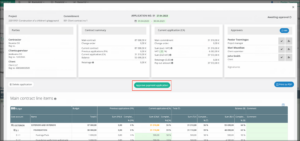When you’re running a construction project, it’s really important to spend as little money as possible. Spending less means you make more money. It’s that straightforward. That’s why keeping an eye on costs and cash flow is a big deal in managing projects and business overall.
First, we’ll explain what cost control is. Then, we’ll go through how you can use cost-control methods in your projects. We’ll also share some ways to control costs effectively. By understanding cost control, you can manage construction projects better.
Table of Contents
What is Cost Control?
Cost control is a method used by businesses in all kinds of industries to find and cut back on any unnecessary costs and spending, making the company more profitable. It starts with creating a budget. Then, the actual money spent is checked against this budget. If the total cost of spending is higher than planned, steps need to be taken to lower these costs.
Reviewing spending is just one way to understand how well a business or project is doing financially. This review helps companies make better plans to keep spending low and spot where they might be using too much money. For some businesses, keeping an eye on how much they spend on suppliers is a big part of controlling costs, because the cost of supplies can be a big chance to save money.
Managing these costs is important, and there is special construction cost and project management software for this, especially for construction projects. Bauwise is a really good software for managing construction costs. It has features that let you see how your project costs compare to your budget in real-time. After you put your project budget into Bauwise, it tracks all your costs and shows them in easy-to-understand charts, comparing what you actually spent, what you planned to spend, and what you budgeted for. It also predicts the cost for each part of your project, helping you see if you’re likely to lose money or make a profit.
Importance of Cost Control In Construction
In the construction industry, the importance of cost control cannot be overstated. It is a crucial cost management and reduction mechanism, ensuring that projects are completed within the allocated budget. This includes a careful approach to overseeing labor costs, materials, and overhead costs, each of which can significantly affect the overall financial health of a construction project.
The cost control process in construction starts with accurate forecasting. The ability to accurately forecast the financial needs of materials, labor, and other resources creates a basis for sticking to the budget. However, just giving an assessment is not enough. Continuous monitoring of costs throughout the project life cycle is essential to avoid cost overruns. Without vigilant oversight, it’s all too easy for cost overruns that can consume a significant portion, if not all, of a general contractor’s budget.
The dynamic nature of construction projects, with their multitude of moving parts and unforeseen challenges, makes cost control customary and imperative. This ensures that every dollar is accounted for and spent wisely, from initial estimates to the final touches. By implementing strong cost control measures, construction companies can protect their profit margins, complete projects within budget, and maintain a competitive edge in a fiercely competitive industry.
Ho to control costs in construction
Keeping an eye on costs as they happen is critical, but it’s just a piece of the bigger picture in managing business costs. You need to watch expenses all the time, but there are things you can do from the start to help keep costs in line. Here’s how to do it in your project or business.
1. Determine your resource requirements
Effective project cost control begins with thorough planning, particularly when it comes to understanding the resources necessary to complete your project or run your business. Resources, which encompass labor, equipment, materials, and other essentials needed to carry out tasks, often represent the bulk of project expenses. Accurately identifying these resources is crucial for keeping costs manageable and the project on budget.
Utilizing a work breakdown structure is a strategic approach to this identification process. This method breaks down the project into smaller, more manageable parts, delineating deliverables and the tasks required to achieve them. Through this detailed breakdown, project managers can precisely list out all the resources needed, from personnel to materials and equipment.
This level of granularity not only aids in the meticulous planning of resource allocation but also enhances the accuracy of cost estimation. By knowing precisely what is needed for each phase and aspect of the project, managers can create a more accurate budget, setting the stage for effective cost control right from the start. This foundational step is vital for the financial health of any project, ensuring that every resource requirement is anticipated and accounted for in the project’s budget.
2. Estimate costs
After identifying what resources your project will need, the next step is to estimate the cost of each resource as accurately as possible. Accuracy here is critical to a successful project budget. To enhance the precision of your cost estimates, it’s advisable to collaborate with your project team. Their hands-on experience and knowledge of the project’s requirements can provide more realistic cost estimates than you might arrive alone.
Additionally, looking into historical financial data of similar projects can offer valuable insights. This data can serve as a benchmark, helping you to understand how much certain aspects of your project might cost based on past experiences. It’s a way of learning from what has been done before to avoid under or overestimating costs.
Expert opinions should not be overlooked in this budgeting process. Professionals with specialized knowledge in certain areas of your project can offer advice and perspective that might not be available within your immediate team. Their expertise can help fine-tune your cost estimates, ensuring your budget is realistic and comprehensive. Seeking and integrating these expert insights can be crucial in achieving a more accurate and effective project budget.
3. Create a Budget
Once you’re clear on what needs to be done and what you’ll need to do, plus you have a good idea of what all this will cost, you’re in a solid position to put together your budget. The accuracy of your budget is crucial. The closer your budget reflects actual costs, the better your chances of sticking to it and keeping your project profitable.
To create your budget, you’ll allocate specific costs to each task in your project schedule. This means every part of your project workflow will be assigned a specific cost, known as a line item, in your budget. This detailed approach ensures that every expense, no matter how small, is accounted for and monitored. By doing this, you get a comprehensive overview of your project’s financial health and set a solid foundation for successful cost control throughout your project’s lifecycle.
4. Track and control costs
With the start of the project implementation phase, the critical task of monitoring and controlling costs also begins. This stage is pivotal because it involves the project manager closely monitoring the progress of the team’s tasks and the costs that accrue as the work progresses. An important part of this process is the establishment of a cost baseline, which serves as a standard against which budgeted costs are compared to actual costs incurred.
Establishing a cost baseline involves documenting the budget in detail, allowing direct comparison when costs are incurred. This comparison is essential to identify when costs exceed the planned budget, signaling the need for immediate action. Cost overruns can upset the financial balance of a project, necessitating adjustments to either the project’s schedule or scope to compensate for unforeseen costs. These adjustments are critical to controlling project costs and ensuring the project aligns with its financial goals.
The ability to effectively use financial resources and track and control costs ensures that the project manager can make informed decisions to keep the project on track whenever financial discrepancies arise. Such vigilance helps avoid budget overruns and plays a vital role in keeping the project completed within the allocated budget.
Cost Control Techniques in Construction
Controlling costs is one of the most important factors for successful project management. Reducing unnecessary expenses, conducting cost forecasts, and minimizing costs help you maintain financial stability in your project management. Learn these cost-control strategies and improve your existing and future projects.
1. Cost reduction
Effective cost control often depends on strategically reducing costs without sacrificing the quality of the product or service delivered. Project managers play an important role in researching and implementing various cost-reduction techniques. These can range from optimizing resource allocation and improving team performance through coaching and retention strategies to process improvements and thoughtful adjustments to project scope. In addition, outsourcing specific tasks or components where necessary can contribute to significant cost savings.
In addition to these project-based strategies, organizations can reduce costs by focusing on operational efficiency. This may include renegotiating supplier contracts to secure more favorable terms, streamlining work processes to eliminate waste and redundancies, reducing expenses, and implementing technologies or methodologies that improve overall efficiency. These efforts aim to reduce costs in a way that does not reduce the value of the end product, ensuring that the organization remains competitive and delivers quality results within tighter budget constraints. With a comprehensive approach to cost reduction, project managers and organizations can protect their projects’ financial health while maintaining the standards that their customers and stakeholders expect.
2. Cost accounting
Cost accounting is a critical process in understanding, tracking, and managing the various variable costs and fixed costs associated with producing and delivering goods and services. This financial practice allows project managers and organizations to comprehensively view their cost structure, facilitating accurate cost allocation. Through detailed cost tracking and analysis, cost accounting empowers teams to implement more effective productivity measures, align projects with corporate strategy, and make strategic decisions that support the bottom line.
By integrating cost accounting into their financial management practices, companies can better adhere to their budgets, refine their pricing strategies, improve operational efficiency, and increase forecasting accuracy. The ultimate goal of cost accounting is to increase net profit margins by ensuring that every decision—from budgeting to enterprise resource planning and allocation—is made with a comprehensive understanding of its cost implications. This not only supports better control over project costs but also aligns product or service pricing with overall business goals, ensuring sustainable and profitable operations.
3. Budgetary Control
Budgetary control is an important financial management tool that focuses on managing both income and expenses within an organization. At the heart of this approach is the constant comparison of actual incurred costs with planned or budgeted costs. This continuous monitoring allows early detection of any financial discrepancies, allowing organizations to identify and address deviations from their financial plans quickly.
The essence of budgetary control is its systematic periodic review and monitoring, where actual expenditures are carefully compared with budgeted amounts. This not only helps in maintaining strict financial discipline but also ensures the effective implementation of cost-control measures. By implementing budget and change control systems, organizations can quickly implement the necessary corrective actions, preventing small differences from escalating into significant financial problems.
This method supports organizations in achieving their financial goals by ensuring that all expenses align with the approved budget. By carefully applying budget control techniques, companies can improve their financial performance, optimize resource allocation, and maintain their competitive advantage by staying on top of their financial health.
4. Variance Analysis
Cost variance analysis is a critical component of financial management that acts as a bridge between planned financial results and actual results achieved. This statistical method, often combined with analysis of variance (ANOVA) techniques, is essential for distinguishing between budgeted cost and actual cost differences, providing a clear view of the financial performance of different accounting categories for a given period or a specific project.
The process helps identify the root causes of cost variances, whether they result from fluctuating material prices, inefficiencies in manufacturing processes, or other operational factors. Organizations can gain valuable information about their financial health by determining whether variances are favorable (when actual costs are less than budget, indicating better-than-expected cost performance elsewhere) or unfavorable (when actual costs exceed budget expectations).
Regular monthly reviews and in-depth analyses at the end of the year or at the end of a project’s life cycle allow financial analysts to delve into important differences. This proactive approach helps correct overspending by identifying necessary cost or expense reductions and promotes a culture of continuous improvement and financial discipline within the organization. By using cost variance and analysis, companies can refine their budgeting processes, streamline operations, and achieve better financial results.
5. Budget
In any organization, a budget is a critical financial plan that outlines expected revenues and expenses over a specified period. This financial planning tool is essential in guiding cost control strategies by providing clear benchmarks for spending on different expense categories. By establishing spending limits and goals, the budget is the basis for an effective cost-control process.
Comparing actual costs to budgeted figures is essential to monitoring expenses and maintaining financial discipline. This continuous monitoring allows organizations to quickly identify when and where financial discrepancies occur, signaling the need for immediate corrective action. This type of proactive expense management also helps align actual spending with the organization’s financial goals, ensuring efficient and strategic use of resources.
Sticking to a budget not only helps to avoid overspending but also plays an important role in strengthening the company’s financial base. This ensures that funds are allocated in a way that supports the organization’s objectives, promoting sustainable growth and maintaining financial stability throughout. Through careful budgeting and other cost control efforts, organizations can navigate financial uncertainty more confidently by making informed decisions that foster long-term success.
6. Cost-Benefit Analysis
A cost-benefit analysis is an essential cost control strategy focusing on foresight to avoid committing to projects that do not promise the desired return on investment. This analytical process is a comprehensive assessment to weigh the potential benefits of a project against its costs. By evaluating the strengths and weaknesses of a proposed project through this lens, decision-makers can assess whether the project is worth the financial risk involved.
The essence of performing a cost-effectiveness analysis is its ability to provide a quantified view of whether the expected benefits of a project sufficiently exceed its costs, thereby justifying the investment. This method does more than just highlight financial viability; it provides a structured approach to analyzing various aspects of a project, including potential revenue, resource allocation, and long-term value to the organization.
Conducting a cost-effectiveness analysis before starting a project ensures that investments are made thoughtfully and with a clear understanding of the financial implications. This is a hedge against projects unlikely to meet their expected financial goals. By making this analysis a standard practice, organizations can improve their financial health and ensure that resources are directed to projects that are viable and aligned with the company’s strategic goals.
7. Earned Value Management
Earned Value Management (EVM) is a comprehensive project management approach that combines insights from cost, schedule, technical scope, and risk to evaluate project performance against a predefined baseline. By comparing the planned value, actual cost, and earned value of work completed, EVM provides a clear picture of a project’s financial and scheduling status. This technique enables organizations to track the progress and value of work effectively, ensuring that project costs are aligned with the budget and schedule. Furthermore, EVM facilitates the early identification of issues, allowing for timely corrective actions to be taken. Through integrating critical project dimensions, EVM emerges as a powerful tool for monitoring performance, forecasting costs, and enhancing overall project management efficiency.
8. Standard cost accounting
Standard costing is a systematic approach in which organizations determine the costs of pre-defined materials, labor, and overheads as a benchmark for evaluating financial performance. By setting these standard costs, companies create a baseline against which actual costs can be measured. This comparison of actual and standard costs is critical in identifying wear and tear discrepancies or variances.
The power of standard costing lies in its ability to highlight areas where financial performance deviates from expectations. If actual costs exceed or fall below these established standards, this signals the need for more in-depth cost analysis to understand the reasons for these differences. This understanding is critical for organizations aiming to refine their cost management strategies and implement effective cost control measures.
Standard cost accounting allows companies to evaluate cost results in different areas of activity systematically. This helps identify inefficiencies and provides a clear direction to improve operational practices. Companies can take targeted actions to improve financial performance, optimize resource utilization, see cost-saving opportunities, and ultimately enhance their overall cost control by understanding where and why costs deviate from expected norms.
Cost Control vs Cost Management
People often confuse cost control with cost management, but they are different concepts that should be properly defined and understood. Cost control is a smaller process in a larger cost management system.
While cost management involves identifying costs and reducing those costs to increase profits, cost management is the overall process of forecasting, budgeting, and controlling project costs.
Conclusion
Controlling costs in construction is crucial for completing your construction project with profit. In this article, we covered the best cost-control techniques and discussed why cost control is important in construction projects. We recommend using Bauwise cost control software to automate construction cost control processes. Bauwise does the heavy lifting for you, so you just need to track the data and see where you’re going over budget and where you are making a profit.
About the Author

Taavi Kaiv
Taavi Kaiv is a construction specialist with over ten years of experience in the construction industry. Taavi is an accomplished construction project manager with many successful projects that have been completed under his guidance. Taavi holds a master’s degree in construction management from the Tallinn University of Technology. View profile
Related posts
Read our articles where you can find useful and relevant information about construction cost control:





